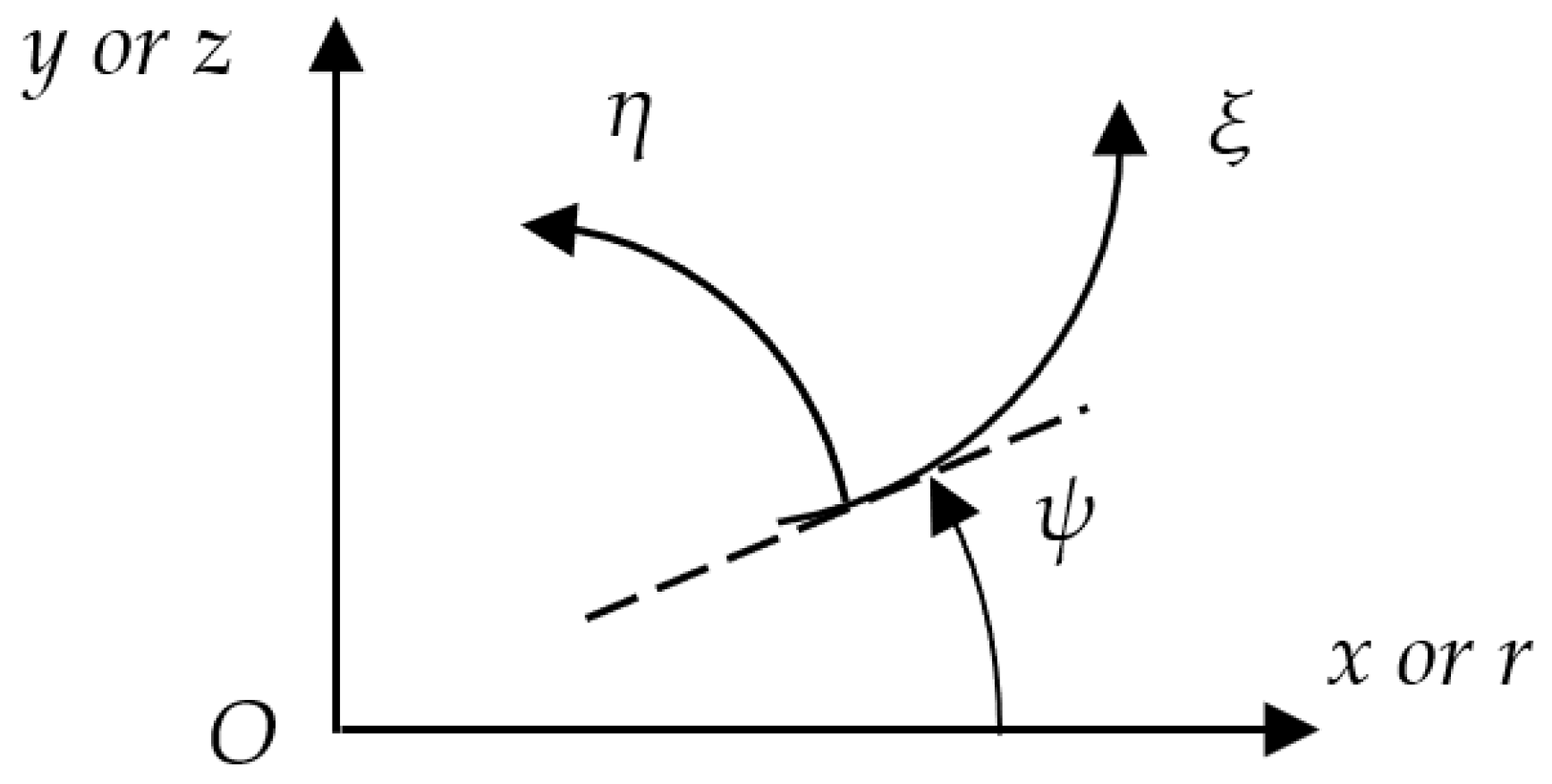Principal Stress Trajectories in Plasticity under Plane Strain and Axial Symmetry
Abstract
:1. Introduction
2. Basic Equations
2.1. Coordinate Systems
2.2. Plasticity
3. Relations between hξ and hη under Plane Strain
3.1. Tresca Yield Criterion
3.2. Mohr-Coulomb Yield Criterion
3.3. Generalized Linear Yield Criterion
3.4. General Yield Criterion
4. Relations between hξ and hη under Axial Symmetry
4.1. Tresca Yield Criterion
4.2. Mohr-Coulomb Yield Criterion
4.3. Generalized Linear Yield Criterion
5. Final Equation Systems under Plane Strain
5.1. Linear Yield Criteria
5.2. General Yield Criterion
6. Final Equation Systems under Axial Symmetry
7. Conclusions
Author Contributions
Funding
Institutional Review Board Statement
Informed Consent Statement
Data Availability Statement
Acknowledgments
Conflicts of Interest
References
- Sadowsky, M.A. Equiareal pattern of stress trajectories in plane plastic strain. ASME J. Appl. Mech. 1941, 63, A74–A76. [Google Scholar] [CrossRef]
- Lippmann, H. Principal line theory of axially-symmetric plastic deformation. J. Mech. Phys. Solids 1962, 10, 111–122. [Google Scholar] [CrossRef]
- Besdo, D. Principal- and slip-line methods of numerical analysis in plane and axially-symmetric deformations of rigid/plastic media. J. Mech. Phys. Solids 1971, 19, 313–328. [Google Scholar] [CrossRef]
- Haderka, P.; Galybin, A.N. The stress trajectories method for plane plastic problems. Int. J. Solids Struct. 2011, 48, 450–462. [Google Scholar] [CrossRef]
- Chung, K.; Alexandrov, S. Ideal flow in plasticity. ASME Appl. Mech. Rev. 2007, 60, 316–335. [Google Scholar] [CrossRef]
- Hill, R. A remark on diagonal streaming in plane plastic strain. J. Mech. Phys. Solids 1966, 14, 245–248. [Google Scholar] [CrossRef]
- Richmond, O.; Morrison, H.L. Streamlined wire drawing dies of minimum length. J. Mech. Phys. Solids 1967, 15, 195–203. [Google Scholar] [CrossRef]
- Richmond, O.; Alexandrov, S. Nonsteady planar ideal plastic flow: General and special analytical solutions. J. Mech. Phys. Solids 2000, 48, 1735–1759. [Google Scholar] [CrossRef]
- Malvern, L.E. Introduction to the Mechanics of a Continuous Medium; Prentice-Hall: Hoboken, NJ, USA, 1969. [Google Scholar]
- Druyanov, B.; Nepershin, R. Problems of Technological Plasticity; Elsevier: Amsterdam, The Netherlands, 1994. [Google Scholar]
- Spencer, A.J.M. Deformation of ideal granular materials. In Mechanics of Solids; Hopkins, H.G., Sewell, M.J., Eds.; Pergamon Press: Oxford, UK, 1982; pp. 607–652. [Google Scholar]
- Cox, G.M.; Thamwattana, N.; McCue, S.W.; Hill, J.M. Coulomb–Mohr granular materials: Quasi-static flows and the highly frictional limit. ASME Appl. Mech. Rev. 2008, 61, 060802. [Google Scholar] [CrossRef]
- Coombs, W.M.; Crouch, R.S.; Heaney, C.E. Observations on Mohr-Coulomb plasticity under plane strain. J. Eng. Mech. 2013, 139, 1218–1228. [Google Scholar] [CrossRef]
- Paul, B. Generalized pyramidal fracture and yield criteria. Int. J. Solids Struct. 1968, 4, 175–196. [Google Scholar] [CrossRef]
- Torkamani, M.A.M. A linear yield surface in plastic cyclic analysis. Comp. Struct. 1986, 22, 499–516. [Google Scholar] [CrossRef]
- Billington, E.W. Generalized isotropic yield criterion for incompressible materials. Acta Mech. 1988, 72, 1–20. [Google Scholar] [CrossRef]
- Kolupaev, V.A.; Yu, M.H.; Altenbach, H. Yield criteria of hexagonal symmetry in the π-plane. Acta Mech. 2013, 224, 1527–1540. [Google Scholar] [CrossRef]
- Meyer, J.P.; Labuz, J.F. Linear failure criteria with three principal stresses. Int. J. Rock. Mech. Min. Sci. 2013, 60, 180–187. [Google Scholar] [CrossRef]
- Druyanov, B. Technological Mechanics of Porous Bodies; Clarendon Press: New York, NY, USA, 1993. [Google Scholar]
- Alexandrov, S.; Date, P. A general method of stress analysis for a generalized linear yield criterion under plane strain and plane stress. Continuum Mech. Thermodyn. 2019, 31, 841–849. [Google Scholar] [CrossRef]
- Kingston, M.R.; Spencer, A.J.M. General yield conditions in plane deformations of granular media. J. Mech. Phys. Solids 1970, 18, 233–243. [Google Scholar] [CrossRef]
- Green, R.J. A plasticity theory for porous solids. Int. J. Mech. Sci. 1972, 14, 215–224. [Google Scholar] [CrossRef]
- Alexandrov, S.; Jeng, Y.-R. A method of finding stress solutions for a general plastic material under plane strain and plane stress conditions. J. Mech. 2021, 37, 100–107. [Google Scholar] [CrossRef]
- Alexandrov, S.; Lyamina, E.A.; Nguyen-Thoi, T. Geometry of principal stress trajectories for a Tresca material under axial symmetry. J. Phys. Conf. Ser. 2018, 1053, 012048. [Google Scholar] [CrossRef]
- Alexandrov, S.; Jeng, Y.-R. Geometry of principal stress trajectories for piece-wise linear yield criteria under axial symmetry. ZAMM J. Appl. Math. Mech. 2020, 100, e20190077. [Google Scholar] [CrossRef]
- Hill, R. Basic stress analysis of hyperbolic regimes in plastic media. Math. Proc. Cambr. Phil. Soc. 1980, 88, 359–369. [Google Scholar] [CrossRef]
- McCue, S.W.; Hill, J.M. Free surface problems for static Coulomb-Mohr granular solids. Math. Mech. Solids 2005, 10, 651–672. [Google Scholar] [CrossRef]
- Ntovoris, E.; Regis, M. A solution with free boundary for non-Newtonian fluids with Drucker–Prager plasticity criterion. ESAIM Control Optim. Calc. Var. 2019, 25, 46. [Google Scholar] [CrossRef]

Disclaimer/Publisher’s Note: The statements, opinions and data contained in all publications are solely those of the individual author(s) and contributor(s) and not of MDPI and/or the editor(s). MDPI and/or the editor(s) disclaim responsibility for any injury to people or property resulting from any ideas, methods, instructions or products referred to in the content. |
© 2023 by the authors. Licensee MDPI, Basel, Switzerland. This article is an open access article distributed under the terms and conditions of the Creative Commons Attribution (CC BY) license (https://creativecommons.org/licenses/by/4.0/).
Share and Cite
Alexandrov, S.; Rynkovskaya, M.; Li, Y. Principal Stress Trajectories in Plasticity under Plane Strain and Axial Symmetry. Symmetry 2023, 15, 981. https://doi.org/10.3390/sym15050981
Alexandrov S, Rynkovskaya M, Li Y. Principal Stress Trajectories in Plasticity under Plane Strain and Axial Symmetry. Symmetry. 2023; 15(5):981. https://doi.org/10.3390/sym15050981
Chicago/Turabian StyleAlexandrov, Sergei, Marina Rynkovskaya, and Yong Li. 2023. "Principal Stress Trajectories in Plasticity under Plane Strain and Axial Symmetry" Symmetry 15, no. 5: 981. https://doi.org/10.3390/sym15050981






